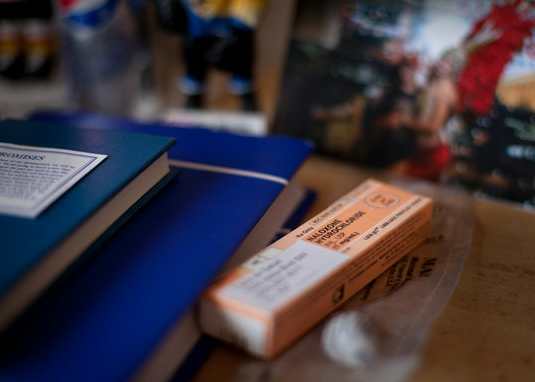Overdoses Plague
 Prescription Drug Overdoses
Prescription Drug Overdoses
Plague New Mexico
By DAN FROSCH. ALBUQUERQUE —
The state has begun the fight against its newest enemy — prescription-drug abuse — which over the last decade has led to a more than 60 percent increase in drug-overdose deaths.
Deep in the South Valley neighborhood, in a cramped medical clinic room adorned with candles and crucifixes, a fresh-faced man who called himself Justin G. told the other addicts how he had gotten hooked.
“This girl I was hanging out with had a prescription for Percocets. I would take them, and next thing you know I’m buying them,” the man recalled. “Then I got a good deal on some OxyContins. But they stopped making those. That’s when I started doing heroin.”
For years now, New Mexico has wrestled with high rates of poverty, drunken-driving deaths and substance abuse — particularly heroin addiction, which has been passed down through generations in the state’s northern, rural reaches. But over the past few years, a new affliction has hammered New Mexico: prescription drug overdoses.
A report released last month by the state’s Health Department found that the drug overdose death rate in New Mexico jumped more than 60 percent between 2001 and 2010.
Public health officials here say the spike is being driven primarily by prescription opioids — painkillers like oxycodone, morphine and methadone — whose sales in the state rose 131 percent during the same period. In New Mexico, the overdose death rate from prescription drugs now outstrips that from illegal drugs, the report found.
Over the last decade, deaths from prescription drug overdoses have risen to unprecedented levels throughout the country, according to the Centers for Disease Control and Prevention.
But medical experts and drug treatment advocates say the problem has become especially pronounced here, where resources have long been focused on other problems. In November, a report from the C.D.C. found that New Mexico had the nation’s highest overall drug overdose death rate.
“As the availability of prescription opioids have increased in New Mexico, so has the overdose death rate. It’s added a new layer to what we have to deal with,” said Dr. Michael Landen, the deputy state epidemiologist. “It’s also a new population that is involved with prescription-drug deaths. It’s much broader.”
Prescription opioid addiction in New Mexico has carved through racial and economic barriers over the past few years, in Albuquerque from the dusty streets of the South Valley to the neatly pruned homes of Northeast Heights.
“Every young person I’ve talked to that’s using heroin always started with pills,” said Jennifer Weiss, president of the Heroin Awareness Committee, formed in 2010 to curb opiate addiction in New Mexico. “It’s just been progressively getting worse.”
Ms. Weiss’s own son, Cameron, a wrestler and football player at La Cueva High School, a local sports powerhouse, became addicted to prescription painkillers after a series of injuries.
Eventually, Cameron told his mother that he had turned to heroin, which was easier to get, prompting Ms. Weiss to start the drug awareness group. Last August, she found him lying on the edge of his bed, dead from a heroin overdose at 18.
“Once they get addicted, they eventually can’t afford the pills anymore. Once you run out of your supply, it makes the most economic sense to start using heroin,” Ms. Weiss said.
Like other states, including Washington and New York, New Mexico has tried to exercise tighter control over the distribution of painkillers.
During the past legislative session, a bill that would have limited the number of opiate pain relievers prescribed to a patient failed to pass, after opposition from some doctors and nurses, who argued that the legislation would harm seriously ill patients.
Dr. Landen said New Mexico’s medical licensing boards were considering some restrictions of their own, like requiring physicians to use the state’s prescription drug database in certain instances to prevent patients from “doctor shopping” for medicine.
Still, there is a concern that creating too many restrictions could push patients to the streets for drugs. And beyond tightening the rules, the solution, some say, ultimately lies with more treatment facilities. Ms. Weiss’s group recently received a $100,000 contract from the City of Albuquerque to plan an adolescent treatment center for opiate addiction.
“There is such a gap in treatment resources in New Mexico in particular, that those of us who have been doing this have pretty much been flooded since Day 1,” said Dr. Andru Zeller, who helped start the Casa de Salud Family Medical Office in Albuquerque in 2004.
Of the 175 patients the clinic treats, about half are opiate pill addicts, Dr. Zeller said. They run the gamut from transients to doctors and counselors.
Patients here are typically treated with dosages of Suboxone, a less stimulating opiate that helps quiet the craving for pain pills and heroin — along with acupuncture, reiki (which involves placing a practitioner’s hands on various body areas to cure ailments) and traditional Mexican healing practices.
On a recent afternoon, three practitioners used reiki and acupuncture to treat a group of addicts, the patients’ feet and arms jerking as they tried to relax. Soon the addicts were fast asleep. Later in the week, there would be another session, a requirement here if patients want their dose of Suboxone. Until then, the group would have to battle their urges on their own.
“I definitely feel less anxious,” said Justin G., after a treatment.
He stepped outside in the burning South Valley sun, the afternoon rush just starting to pick up. He took a deep breath and headed off.
